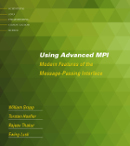Home
Publications
edited volumes
Awards
Research
Teaching
Miscellaneous
Full CV [pdf]
BLOG
bio


Events





Past Events






|
Publications of Torsten Hoefler
Christoph Schär, Oliver Fuhrer, Andrea Arteaga, Nikolina Ban, Christophe Charpilloz, Salvatore Di Girolamo, Laureline Hentgen, Torsten Hoefler, Xavier Lapillonne, David Leutwyler, Katherine Osterried, Davide Panosetti, Stefan Rüdisühli, Linda Schlemmer, Thomas Schulthess, Michael Sprenger, Stefano Ubbiali, Heini Wernli:
| | | Kilometer-scale climate models: Prospects and challenges
(Bulletin of the American Meteorological Society. Vol 100, Nr. 12, American Meteorological Society, Dec. 2019, Early Online Release )
Publisher Reference
AbstractKilometer-resolution climate models provide exciting prospects, as they will explicitly represent convective clouds. We explore this approach using a limited-area atmospheric model and discuss 67 prospects, challenges and potential solutions.
Currently major efforts are underway towards refining the horizontal resolution (or grid spacing) of climate models to about 1 km, using both global and regional climate models (GCMs and RCMs). Several groups have succeeded in conducting km-scale multi-week GCM simulations, and decade-long continental-scale RCM simulations. There is the well-founded hope that this increase in resolution represents a quantum jump in climate modeling, as it enables replacing the parameterization of moist convection by an explicit treatment. It is expected that this will improve the simulation of the water cycle and extreme events, and reduce uncertainties in climate-change projections. While km-scale resolution is commonly employed in limited-area numerical weather prediction, enabling it on global scales for extended climate simulations requires a concerted effort. In this paper, we exploit an RCM that runs entirely on graphics processing units (GPUs) and show examples that highlight the prospects of this approach. A particular challenge addressed in this paper relates to the growth in output volumes. It is argued that the data avalanche of high-resolution simulations will make it impractical or impossible to store the data. Rather, repeating the simulation and conducting online analysis will become more efficient. A prototype of this methodology is presented. It makes use of a bit-reproducible model version that ensures reproducible simulations across hardware architectures, in conjunction with a data virtualization layer as a common interface for output analyses. An assessment of the potential of these novel approaches will be provided.
DocumentsPublisher URL: https://journals.ametsoc.org/doi/abs/10.1175/BAMS-D-18-0167.1download article: 
| | | BibTeX | @article{,
author={Christoph Schär and Oliver Fuhrer and Andrea Arteaga and Nikolina Ban and Christophe Charpilloz and Salvatore Di Girolamo and Laureline Hentgen and Torsten Hoefler and Xavier Lapillonne and David Leutwyler and Katherine Osterried and Davide Panosetti and Stefan Rüdisühli and Linda Schlemmer and Thomas Schulthess and Michael Sprenger and Stefano Ubbiali and Heini Wernli},
title={{Kilometer-scale climate models: Prospects and challenges}},
journal={Bulletin of the American Meteorological Society},
year={2019},
month={Dec.},
volume={100},
number={12},
publisher={American Meteorological Society},
note={Early Online Release},
source={http://www.unixer.de/~htor/publications/},
} |
|
|



























